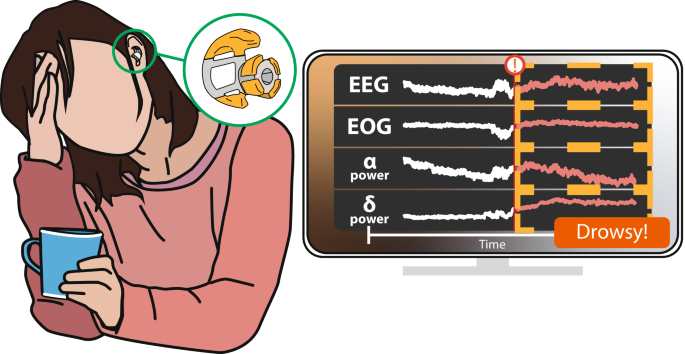2024-08-05 カリフォルニア大学バークレー校(UCB)
◆カリフォルニア大学バークレー校のエンジニアは、眠気の兆候を検出できるプロトタイプのイヤホンを開発しました。このイヤホンは脳波を検出するために耳内の電極を使用し、特に眠気に関連するアルファ波を検出できます。研究では、イヤホンが従来の大規模なEEGシステムと同様の精度で眠気を分類できることを示しました。
<関連情報>
- https://news.berkeley.edu/2024/08/05/dozing-at-the-wheel-not-with-these-fatigue-detecting-earbuds/
- https://www.nature.com/articles/s41467-024-48682-7
- https://ieeexplore.ieee.org/document/9115876
眠気をモニターするワイヤレス耳脳波計 Wireless ear EEG to monitor drowsiness
Ryan Kaveh,Carolyn Schwendeman,Leslie Pu,Ana C. Arias &Rikky Muller
Nature Communications Published:02 August 2024
DOI:https://doi.org/10.1038/s41467-024-48682-7

Abstract
Neural wearables can enable life-saving drowsiness and health monitoring for pilots and drivers. While existing in-cabin sensors may provide alerts, wearables can enable monitoring across more environments. Current neural wearables are promising but most require wet-electrodes and bulky electronics. This work showcases in-ear, dry-electrode earpieces used to monitor drowsiness with compact hardware. The employed system integrates additive-manufacturing for dry, user-generic earpieces, existing wireless electronics, and offline classification algorithms. Thirty-five hours of electrophysiological data were recorded across nine subjects performing drowsiness-inducing tasks. Three classifier models were trained with user-specific, leave-one-trial-out, and leave-one-user-out splits. The support-vector-machine classifier achieved an accuracy of 93.2% while evaluating users it has seen before and 93.3% when evaluating a never-before-seen user. These results demonstrate wireless, dry, user-generic earpieces used to classify drowsiness with comparable accuracies to existing state-of-the-art, wet electrode in-ear and scalp systems. Further, this work illustrates the feasibility of population-trained classification in future electrophysiological applications.
ワイヤレス耳脳波計 Wireless User-Generic Ear EEG
Ryan Kaveh; Justin Doong; Andy Zhou; Carolyn Schwen;…
IEEE Transactions on Biomedical Circuits and Systems Published:12 June 2020
DOI:https://doi.org/10.1109/TBCAS.2020.3001265
Abstract
In the past few years it has been demonstrated that electroencephalography (EEG) can be recorded from inside the ear (in-ear EEG). To open the door to low-profile earpieces as wearable brain-computer interfaces (BCIs), this work presents a practical in-ear EEG device based on multiple dry electrodes, a user-generic design, and a lightweight wireless interface for streaming data and device programming. The earpiece is designed for improved ear canal contact across a wide population of users and is fabricated in a low-cost and scalable manufacturing process based on standard techniques such as vacuum forming, plasma-treatment, and spray coating. A 2.5 × 2.5 cm 2 wireless recording module is designed to record and stream data wirelessly to a host computer. Performance was evaluated on three human subjects over three months and compared with clinical-grade wet scalp EEG recordings. Recordings of spontaneous and evoked physiological signals, eye-blinks, alpha rhythm, and the auditory steady-state response (ASSR), are presented. This is the first wireless in-ear EEG to our knowledge to incorporate a dry multielectrode, user-generic design. The user-generic ear EEG recorded a mean alpha modulation of 2.17, outperforming the state-of-the-art in dry electrode in-ear EEG systems.


